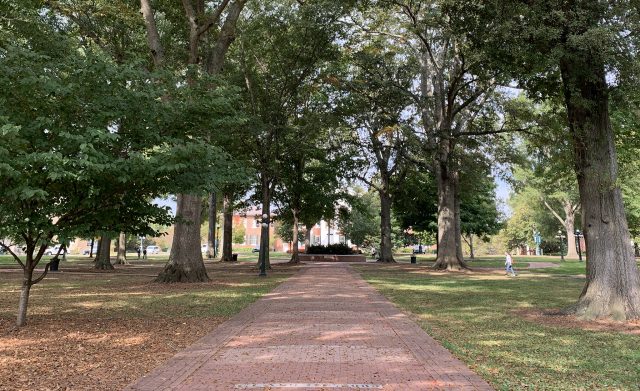
This area of the Circle will be transformed into an outdoor ‘concert hall’ at lunchtime Tuesday (Oct. 13) for a recital by the UM Faculty Woodwind Quintet. Photo by Lynn Adams Wilkins/UM Department of Music
OXFORD – With precautions and protocols in place to help prevent the spread of COVID-19, a live music experience may feel like a thing of the past. But five music professors at the University of Mississippi are going out of their way to present music in a safe, outdoor setting on Tuesday (Oct. 13).
The UM Faculty Woodwind Quintet will present two pieces of music in the Circle on the Ole Miss campus, starting at 12:15 p.m.
“We’ll begin with a short piece by Poulenc that is just a few minutes long to alert folks to our presence,” said Michael Rowlett, associate professor of clarinet. “Then we’ll play a longer, more contemporary piece by Nat Evans called ‘Music for Breathing.'”
The free recital will take about 20 to 25 minutes, Rowlett said.
“‘Music for Breathing’ seems perfect for an outdoor performance,” said Adam Estes, associate professor of music, who plays bassoon in the quintet, noting that the score for “Music for Breathing” reads “for woodwind quintet with additional natural objects.”
“The composer asks each instrumentalist to play conch shells that have been fitted for playing like a horn, to rub stones together and to play their instruments in both traditional and nontraditional ways.”
The quintet includes flute, oboe, clarinet, French horn and bassoon.
The performers will stand in a circle, facing one other, on either side of the sidewalk just east of the flagpole. They will remain 15 feet apart to abide by the most recent guidelines for wind instrument playing, and a barrier will be in place to ensure that listeners remain at a safe distance.
“People should be able to stand anywhere in the larger area of the Circle, even across the circular drive from us, and be able to see and hear us playing, so there will not be a need for listeners to congregate to enjoy the performance,” Rowlett said.
Besides teaching French horn at UM, adjunct instructor Leander Star performs with The City of Tomorrow wind quintet, which premiered “Music for Breathing.” When the New York-based ensemble first rehearsed the piece, they didn’t know what to expect, he said.
“We got our hands on the five conch shells called for in the score and picked up some rocks in Central Park,” Star recalled. “We rehearsed late at night in a top-floor practice room during an intense thunderstorm. It was a magical moment; we kept looking at each other, struck by the beautiful effect.”
When the Faculty Woodwind Quintet decided to stage an outdoor performance, Star immediately thought of “Music for Breathing” for two reasons.
It’s a work that feels especially connected to the natural world and perfect for playing outside. The sections played on regular instruments feel almost holy, and the conches sound like whales or wolves, Star said.
The combination gives the effect of connection and communion – not only within the natural world, but also with something more spiritual, he said.
The other reason Star suggested Nat Evan’s work was how it seems to celebrates the very act of performance.
“The score of this piece is a great balance of, on the one hand, dictated notes and melodies, and on the other, improvisatory freedom to choose when and how those notes and fragments occur,” he said. “This emboldens the performers’ natural musical sense and gives them freedom to react and respond to their colleagues.
“In this way, it is an especially refreshing piece to perform when you haven’t had the opportunity to play with other musicians in months!”
Other members of the quintet agreed.
“I was attracted by the title, ‘Music for Breathing,'” Rowlett said. “As we are all focused on a virus that primarily affects respiration, it seems timely to present a work with that title. Breathing is so fundamental to our being and, as wind players, it is the medium that we use to make our art.
“Now, more than ever, seems like the perfect time to share a piece that encourages reflection on life-giving air.”